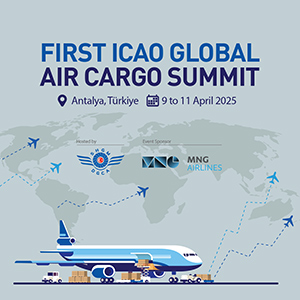- Global demand, measured in cargo tonne kilometers (CTKs*), fell by 15.2% in March compared to the previous year (-15.8% for international markets).
- Global capacity, measured in available cargo tonne kilometers (ACTKs), shrank by 22.7% in March compared to the previous year (-24.6% for international markets).
- International markets account for 87% of air cargo. Belly capacity for international air cargo shrank by 43.7% in March compared to the previous year. This was partially offset by a 6.2% increase in capacity through expanded use of freighter aircraft, including the use of idle passenger aircraft for all-cargo operations.
“At present, we don’t have enough capacity to meet the remaining demand for air cargo. Volumes fell by over 15% in March compared to the previous year. But capacity plummeted by almost 23%. The gap must be addressed quickly because vital supplies must get to where they are needed most. For example, there is a doubling of demand for pharmaceutical shipments that are critical to this crisis. With most of the passenger fleet sitting idle, airlines are doing their best to meet demand by adding freighter services, including adapting passenger aircraft to all-cargo activity. But mounting these special operations continues to face bureaucratic hurdles. Governments must cut the red tape needed to approve special flights and ensure safe and efficient facilitation of crew,” said Alexandre de Juniac, IATA’s Director General and CEO.
There are still too many examples of delays in getting charter permits issued, a lack of exemptions on COVID-19 testing for air cargo crew, and inadequate ground infrastructure to/from and within airport environments. Air cargo needs to move efficiently throughout the entire supply chain to be effective. IATA urges governments to:
- Cut the paperwork for charter operations
- Exempt cargo crew from quarantine rules that apply to the general population
- Ensure there is adequate staff and facilities to process cargo efficiently
Slow Recovery
While there is an immediate capacity shortage, the collapsing economy is expected to further depress overall cargo volumes.
Short-term analysis shows that global manufacturing activity continued to contract in March as government-imposed lockdowns caused widespread disruptions. Following the sharp decline in February – which exceeded that of the global financial crisis – the global manufacturing Purchasing Managers’ Index (PMI) rose slightly in March but remained in contractionary territory. This improvement was due to the stabilization of the China PMI; excluding the China outcome, the global index fell to its lowest level since May 2009.
Looking at the prospects for the rest of 2020, the World Trade Organization forecast gives little indication of a quick recovery. The optimistic scenario is for a 13% fall in trade in 2020, while the pessimistic scenario sees a 32% fall in trade in 2020. This will deeply impact air cargo’s prospects.
One area of demand, however, is growing sharply. Pharmaceutical shipments are tracking at double previous-year volumes. This excludes shipments of medical equipment.
“The capacity crunch will, unfortunately, be a temporary problem. The recession will likely hit air cargo at least as severely as it does the rest of the economy. To keep the supply chain moving to meet what demand might exist, airlines must be financially viable. The need for financial relief for airlines by whatever means possible remains urgent,” said de Juniac.
Regional Performance | |||||||||||||||||||||||||||||||||||||||||||||||||
| |||||||||||||||||||||||||||||||||||||||||||||||||
|
- Airlines Asia-Pacific airlines saw demand for international air cargo fall by 15.9% in March 2020, compared to the year-earlier period. Seasonally adjusted cargo demand fell by 3.0% compared to February 2020, to levels last seen in the third quarter of 2013. International capacity decreased 27.8%.
- North American carriers reported a decline in international demand of 13.3% annually in March which was more than double the pace of decline in February (-6.1%). Cargo volumes on the Europe-North America trade lane were affected the most (down 22% year-on-year) in March. International capacity decreased 19%.
- European carriers reported an 18.8% annual drop in international cargo volumes in March, much sharper than the outcome for February (-5.2%). Intra-Europe demand declined by 32.6% year-on-year due to widespread shutdowns in the manufacturing sector across the region. The larger Europe-North America and Europe-Asia markets also recorded substantial declines this month. International capacity decreased 27.6%.
- Middle Eastern carriers reported a decline of 14.1% year-on-year following growth of 4.3% in February. Among all routes to/from the Middle East, the sizeable Europe and Asia trade lanes recorded falls in the order of 20% in March, while the smaller Africa market saw a decline of around 30%. International capacity decreased 20.4%.
- Latin American carriers posted the sharpest fall—a 19.3% year-on-year decline in international demand. This was a significant deterioration compared to February (-0.5%). Declines were widespread but most severe for Central-South America with volumes down around 35% year-on-year. International capacity decreased 37.6%.
- African airlines were less affected by disruptions in March. They saw year-on-year growth in international CTKs fall by 1.2% following the positive annual outcomes in January and February. The Africa-Asia market was the only trade lane which continued to post growth in March, with volumes up almost 10% year-on-year. International capacity decreased 8.2%.





























Türkçe karakter kullanılmayan ve büyük harflerle yazılmış yorumlar onaylanmamaktadır.